The problem of re-erection of so-called Marian Column in the Old Town Square in Prague is current and frequently discussed issue. The society VERITAS has been interested in this problem for a long time and that is why the whole section of our website is dedicated exclusively to this problem.
- Picture gallery of the “Marian Column” according to the period engravings
- The 1998 Letter of the Society VERITAS on so-called Marian Column
- So-called Marian Column in the Old Town Square in Prague (information about its history, its true significance and determined efforts towards its re-erection)
- Text of the petition against re-erection of so-called Marian Column in the Old Town Square in Prague
- Support of the other Organization's Statements
Available only in Czech:
- What was so-called Marian Column in the Old Town Square
Download a study document (7 pages and picture appendix)
sloup.pdf (791 kB, Adobe® Portable Document Format) - New monument to the Old Town Square (polemic by Zdeněk Zacpal from 2004)
- The role of Milada Horáková (nee Králová) during the Column Removal on November 3, 1918
- The Survived Star from the Halo of the Virgin Mary
Picture gallery of the “Marian Column”
according to the period engravings
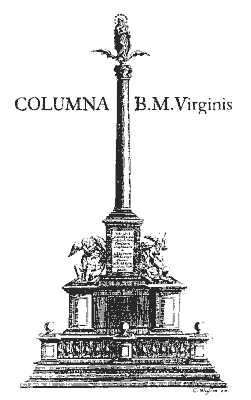
So-called “Marian Column” in the Old Town Square in Prague
(period engraving)
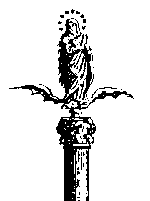
The statue of Virgin Mary stepping on dragon's head
(detail of the top of the column, period engraving)
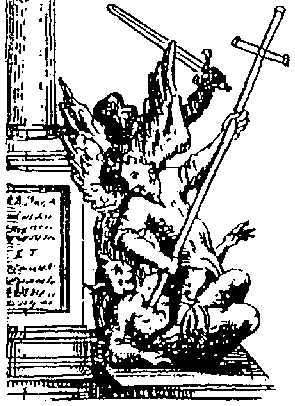
The original right front of the sculptural group in a 1685 engraving
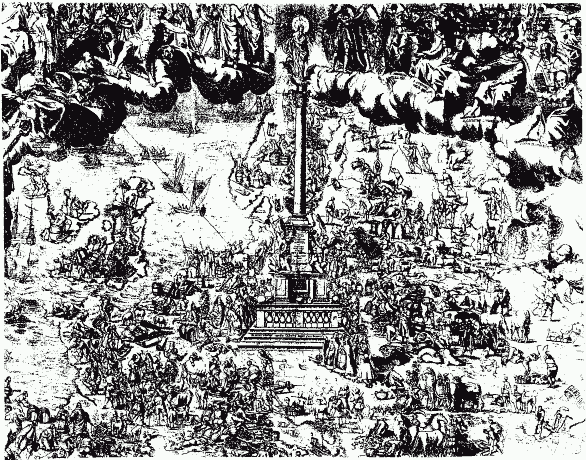
Karel Škréta: “The Marian Column” in the Old Town Square in Prague representing the spiritual centre of Europe (cut of the engraving)
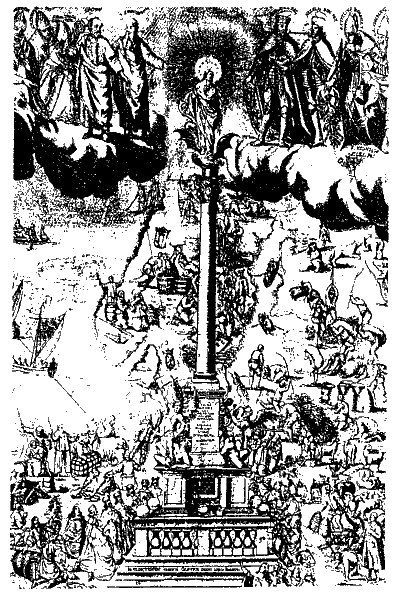
A detailed picture of the Apostles and Roman Catholic patron saints blessing the column in Prague as the centre of the Catholic Europe
The letter of the Society VERITAS
addressed to congregations, religious communities and church fellowships
in the Czech Republic
You have probably noticed some information or discourse in connection with efforts to re-erect so-called “Marian Column” in the Old Town Square in Prague. Since the information are oftentimes inaccurate, we take the liberty of introducing to you the true historical facts in this brief form.
“The Marian Column” was consecrated on July 13, 1652 in presence of the Emperor Ferdinand III, which proves this event to have political background. The inscription on its pedestal read: “To immaculate Virgin Mary for defence and liberation of the city by the pious and righteous Emperor.” The memorial, about sense of which professor J. Pekař wrote, that it glorifies victory over the Czech Reformation and over the Czech state and that it is not only memorial of Marian piety as many defenders of re-erection of the column try to claim, was erected in the heart of Europe four years after saving Prague from the Swedish Army (protectors of the Reformation) and signing the Westphalian Peace (which definitely ended the period of religious freedom in Bohemia and Moravia and which prevented the exiles, including J. A. Comenius, from returning to their homeland).
The picture by Škréta, well-known from his 1661 engraving in which the Marian Column is construed as the future centre of the Catholic Europe, makes an impressive witness of how important role was attributed to the column. The map of Europe in the picture clearly shows the intended sphere of power of the column. It includes not only the southern and south-western Roman Catholic Europe and Central Europe occupied after the Westphalian Peace, but also eastern and northern Europe, which “belonged” to the Orthodox and Protestants. Therefore it indirectly suggested that this column was intended to be in the future the centre of so-called united Europe, however, with one exclusive religion — post-Trident Roman Catholicism.
The column was pulled down shortly after proclamation of the independent state, on November 3, 1918. On the same day, there was a mass demonstration of 30000 people on the White Mountain. That may have been the reason why some of the Catholic historians mistakenly assumed that the column was pulled down by the mob. In fact it was pulled down by the firemen of Žižkov district, who were turned into this action by František Sauer. The whole incident was not considered as an act against the public interest or even vandalism, which can be proved by the fact that no legal action was taken against either F. Sauer, who did not try to dissociate himself from the incident, or the firemen of Žižkov.
The idea of re-erection of the column started to spread among our countrymen in USA, especially in Chicago, in the 1950's. Their efforts resulted in establishing of the Society for Re-erection of the Marian Column in 1990. The preparatory committee announced, among other proclamations, that: “This monument was thoughtlessly destroyed by the mob in the first days of independence in 1918. The participants agreed that this act has been a blot on the cultural reputation of the Czech nation up to the present time and that time to redress this blot has come.” The society takes purposeful measure to re-erection of the “Marian column”.
Although re-erection of the column was not permitted due to negative attitude of the department of conservation of the Prague's municipal government, preparations still go on. In November 1993, a stone plate was embedded into the pavement in the Old Town Square. The plate reads: “Here stood and will stand again the Marian Column.” The society was due to pay a fine, because the municipal government only permitted to mark the spot were the column used to stand. Nevertheless, it did not prevent the society from starting a national fund-raising campaign in order to collect financial means.
Pursuit of re-erection of the column is an anachronism from the urbanistic viewpoint, too. The square today looks completely different than in the 17th century. And because we now live in a free and democratic state, this attempt to rebuild a memorial of the “first iron curtain” would for most of the people equal to efforts to build e.g. a memorial of the “Protectorate Bohemia und Moravia” or “brotherly help in 1968” — i.e. glorification of the end of independence of our nation and state.
We believe that this letter will “wake up” members of reformational Churches and other citizens who take concern in truth and are not indifferent to the fate of our state. If you are interested in receiving any detailed documents regarding this topic, you may refer to our society at any time. If necessary, we will provide additional information. We hope that you will not refuse to co-operate in our activities and that you will forward this letter to your friends and neighbours.
On behalf of the Society for Updating the Legacy of the Czech Reformation VERITAS
Published: Evangelic Weekly
Sparks of Constance 83, 1998, No. 7, February 18, 1998;
The Voice of the Centre of
Czech Reformation No. 2/1998, p. 11.
So-called Marian Column in the Old Town Square in Prague
(information about its history, true significance
and determined offorts towards its re-erection)
The Marian Column (its construction was finished on September 30, 1650) was consecrated on July 13, 1652 in presence of the Emperor Ferdinand III, which proves this event to have political background. The inscription on its pedestal reads: “To immaculate Virgin Mary for defence and liberation of the city by the pious and righteous Emperor.” On the top of the column there was a statue of Virgin Mary stepping on dragon's head. Dragon symbolizes defeated Protestants — heretics. On the pedestal there were four other sculptural groups showing similar symbols — annihilation of heretics — devils — fighting against angels, who carry cross and sword in their hands, i.e. symbols of sacred and secular powers. The construction of this column was inspired by the column (sculptor P. Candidus) that had been erected in 1638 in Munich by the Duke Maxmilian in remembrance of victory of the imperial army in the Battle of the White Mountain in 1620.
The memorial, about sense of which professor J. Pekař wrote, that it glorifies victory of legitimacy and Catholicism over the heretic kingdom, was erected in the heart of Europe four years after saving Prague from the Swedish Army (protectors of the Reformation) and signing the Westphalian Peace (which definitely ended the period of religious freedom in Bohemia and Moravia and which prevented the exiles, including J. A. Comenius, from returning to their homeland). This Pekař's statement legitimized a justifiable opinion that the column was not solely a memorial of Marian piety, as some of its defenders try to claim, but also a memorial of victory over the Czech Reformation and Czech state.
The picture by Škréta, well-known from his 1661 engraving in which the Marian Column is construed as the future centre of the Catholic Europe, makes an impressive witness of how important role was attributed to the column. The map of Europe in the picture clearly shows the intended sphere of power of the column. It includes not only the southern and south-western Roman Catholic Europe and Central Europe occupied after the Westphalian Peace, but also eastern and northern Europe, which “belonged” to the Orthodox and Protestants. Therefore it indirectly suggested that this column was intended to be in the future the centre of so-called united Europe, however, with one exclusive religion — post-Trident Roman Catholicism (the Council of Trident, 1545–63, refused to negotiate with Protestants).
The column was pulled down shortly after proclamation of the independent state, on November 3, 1918. On the same day, there was a mass demonstration of 30000 people on the White Mountain. That may have been the reason why some of the Catholic historians mistakenly assumed that the column was pulled down by the mob. In fact it was pulled down by the firemen of Žižkov district, who were turned into this action by František Sauer. The whole incident was not considered as an act against the public interest or even vandalism, which can be proved by the fact that no legal action was taken against either F. Sauer, who did not try to dissociate himself from the incident, or the firemen of Žižkov.
The idea of re-erection of the column started to spread among our countrymen in USA, especially in Chicago, in the 1950's. Their efforts resulted in establishing of the Society for Re-erection of the Marian Column in 1990. The preparatory committee announced, among other proclamations, that: “This monument was thoughtlessly destroyed by the mob in the first days of independence in 1918. The participants agreed that this act has been a blot on the cultural reputation of the Czech nation up to the present time and that time to redress this blot has come.” The society takes purposeful measure to re-erection of the “Marian column”.
Although re-erection of the column was not permitted due to negative attitude of the department of conservation of the Prague's municipal government, preparations still go on. In November 1993, a stone plate was embedded into the pavement in the Old Town Square. The plate reads: “Here stood and will stand again the Marian Column.” The society was due to pay a fine, because the municipal government only permitted to mark the spot were the column used to stand. Nevertheless, it did not prevent the society from starting a national fund-raising campaign in order to collect financial means.
Pursuit of re-erection of the column is an anachronism from the urbanistic viewpoint, too. The square today looks completely different than in the 17th century. And because we now live in a free and democratic state, this attempt to rebuild a memorial of the “first iron curtain” in Europe would for most of the people equal to e.g. hanging out flags with swastikas or renewal of Stalin's memorial. All of these symbols are surely symbols of totalitarianism.
This year, the whole thing has become very topical. The Society for Re-erection of the Marian Column escalates its efforts towards its renewal in the Old Town Square. Because this memorial surely has a political background and religion was just misused, it is necessary that conscious citizens prevent the Society from re-erecting of this column at the place where its existence would equal to official proclamation of totalitarianism in our state.
Some important information:
What, in fact, are Marian columns?
They are columns with statues of Virgin Mary, which have nothing to do with any political event (e.g. in Hradčany Square, in Zlíchov) and were not pulled down.
What are plague columns?
They are memorials that express thanks for the end of plague outbreaks in the locality (there was no plague outbreak in Prague in 1650, not even a note of plague outbreak could ever been found on the column in the Old Town Square).
Who ordered the engraving by Karel Škréta?
The engraving was made on the basis of ideological proposal of Jan Bedřich of Valdštejn, the future Prague's archbishop, who stood up for this very conviction — i.e. that the Marian Column should be the centre of the re-catholized Europe.
Is there any evidence of ideological use of the “Marian Column” in the Old Town Square?
Processions with prayers were regularly held there on the eve of the anniversary of the Battle of the White Mountain of course in presence of the Habsburg Emperors (Ferdinand III and Leopold I). The processions were prohibited during the reign of Joseph II.
Published: The Bulletin VERITAS, No. 10/2001, pp. 12–14.
Petition against re-erection of so-called Marian Column in the Old Town Square in Prague
This petition was initiated by the Society VERITAS in 2001. The signed sheets were submitted to ing. arch. Jan Kasl, the City Mayor of Prague of that time.
“We do not agree with the intention of re-erection of so-called Marian column in the Old Town Square in Prague, which is promoted by the Society for Re-erection of the Marian Column. Our reasons for this petition are following:
1. The Marian Column erected by the Habsburg Emperor Ferdinand III in the Old Town Square in 1650 was not a regular Marian column as we know it from different places, but it was a memorial of political importance. The statue of Virgin Mary on the top of it was misused in order to glorify the victory of Catholicism, represented by the Habsburgs, over the Czech nation of which 90 % was Protestant.
2. The authentic period documents describe the ideological intent of the column: there are four sculptural groups on its pedestal, they each portray symbols of religious and political power — an angel with sword and an angel with cross annihilating devils, who represent Protestantism. Over them, there is a victorious statue of Virgin Mary stepping on the head of a dragon — representing Protestantism.
3. Škréta's painting, made on the basis of ideological proposal of Prague's archbishop J. B. of Valdštejn in 1661, proves significance and intent of this column erected in the Old Town Square in Prague as a symbol of the future center of recatholization of all Europe from the West to Caucasus.
4. It glorifies victory of cruel violence over free development of the Czech Lands and it is a symbol of ideological and power monopoly of the Roman Catholic Church, which is in sharp contrast with the principals of democracy and the General Declaration of Human Rights, which the Czech Republic acknowledge.
5. Because of the fore mentioned symbolism, the Marian column in the Old Town Square was the only column to be pulled down intentionally. It's symbolism was in sharp contrast with ideals of the new born, free and independent Czechoslovakia in 1918. That is why nobody was punished for pulling it down and it has never been re-erected, however, other regular Marian columns were being re-erected.
6. Determined efforts towards re-erection of the Marian Column in the Old Town Square whatever it takes (despite the fact that after its destruction there is a lack of the original material to make its copy), are clear evidence that its renewal means restoration of its updated ideological and political significance.
7. Renewal of this memorial would be in sharp contrast with the apology of the pope John Paul II for the forcible recatholization in the period that followed the Battle of the White Mountain, symbol of which this column was.
Dear Mr. City Mayor,
we apply to you and all those who will be in charge to make decisions in this matter, not to yield to the pressure and make the final decision not to re-erect the Marian Column in the Old Town Square, moreover near the place where the brutal execution of 27 bold representatives of the Czech nation took place. They opposed the cruel violence, injustice and lack of freedom that exposed our nation to such a suffering and humiliation, which this column glorifies.”
Support of other Organization's Statements
The Administrative Board of VERITAS sent in July 2003 a letter to the Czechoslovak Hussite Church patriarch ThDr. Jan Schwarz with an agreement and support of his statement. It was a reaction to Schwarz's repeated refusal of efforts to re-erect the Marian Column in the Old Town Square in Prague and his words of satisfaction upon the fact that no member of CHC also asks for return of the golden chalice to the facade of Virgin Mary Church in front of Týn (it was overthrown and recasted into Virgin Mary statue after the Battle on the White Mountain) that he had said July 6, 2003 to the John Huss' feast. Brother patriarch responded to be grateful for our support and welcomes our initiative in this issue.
 VERITAS, r.a.
VERITAS, r.a.


